Advertisement
Freddie Mac outlook: Will recovery be experienced equally across all states?

Economic indicators point toward modest economic growth during the third quarter. Analysts will debate whether this marks the start of a fledging recovery, but the consensus view is that the longest, deepest recession since the 1930s has passed. At the national level things are looking better, but at a local level the story is mixed. Examination of state-level economic data reveals regional differences in economic performance, with some states likely to recover more quickly, and some slower, than the nation as a whole. In particular, states may be clustered into three broad groups: the “housing bubble” states of California, Nevada, Arizona and Florida, where house prices increased well above the U.S. norm during 2004-2006; the industrial Midwest area of Illinois, Indiana, Ohio and Michigan; and the rest of the country. Three economic performance measures are of note: employment, housing starts, and home sales.
The non-farm payroll employment numbers show that nearly all states fell into recession in late 2007/early 2008 – employment was rising prior to then and has been falling since. Four states differ markedly from this pattern, however – Alaska, Louisiana and North Dakota have all added jobs or maintained the level from the fourth quarter of 2007 and Michigan has shed jobs each year since 2000. Nationally, job losses stand at over seven million since the start of the recession, out of non-farm payroll employment that peaked at 138 million in December 2007. But while most states show a similar time pattern to job losses, the effects have not been proportionately distributed. The four bubble and four industrial Midwest states employed one-third of all U.S. workers at the start of the recession, but have absorbed half of the jobs lost. The reasons for the job loss differs: In the bubble states it is attributable to the drop in home values and construction, while in the industrial mid-west it has to do largely with manufacturing layoffs.
Nationally, one-family housing starts hit a post-1945 nadir during the first quarter. The trend is very consistent across all states – house construction peaked at the end of 2005 and has steadily fallen since then. Housing starts are 60 to 90 percent below their mid-decade highs, based on state-level building estimates from Moody’s Economy.com. All four “bubble” states and Illinois, Michigan and Ohio from the industrial Midwest are among the 10 states that saw declines in housing starts of at least 80 percent. A new trend may be emerging, however, starting in the second quarter – one-family housing starts rose in every state except Kentucky.
Home sales, too, seem to have hit a turning point – in all but three states, existing home sales during the second quarter of this year are above their troughs, according to the National Association of Realtors (NAR). In most cases, sales bottomed out in either the third or the fourth quarter of 2008, after having fallen 20 to 60 percent from peak levels. Here the bubble states markedly stand out from the rest in that the timing of their trough was about a year earlier, and the subsequent upswing is on the order of 15 to 65 percentage points – all other states range from zero to 13 percentage-point rebounds. Why are the bubble states so different?
The connection may be in foreclosures and home prices. In these four states, foreclosures that were first driven by subprime loans and later by alt-A loans hit both harder and earlier than elsewhere in the country. Correspondingly, home prices have fallen the fastest in these states, in some areas by more than 50 percent. With mortgage rates at 50-year lows, homes selling at half price and the first-time homebuyer tax credit, buyers are being lured off the fence in these markets. In California, inventories of homes for sale have become tight for homes priced below $500,000, where the months’ supply has fallen from six to nine months in the summer of 2008 to about three to four months this past summer, encouraging would-be buyers to stop procrastinating lest they lose out on potential bargains.
The backlog of loans in foreclosure has the potential to derail the momentum in the housing markets if a large wave of properties transition through foreclosure faster than buyers can absorb them. However, if buyer sentiment has truly changed, they may simply view the new supply of distressed properties for sale as a great opportunity for getting a bargain. An additional risk is the pending expiration of the first-time homebuyer tax credit and what will happen to interest rates: The consensus view is that fixed-rate mortgage rates could average one-quarter to one-half percentage points above their current levels in 2010.
For more information, visit FreddieMac.com.
About the author





